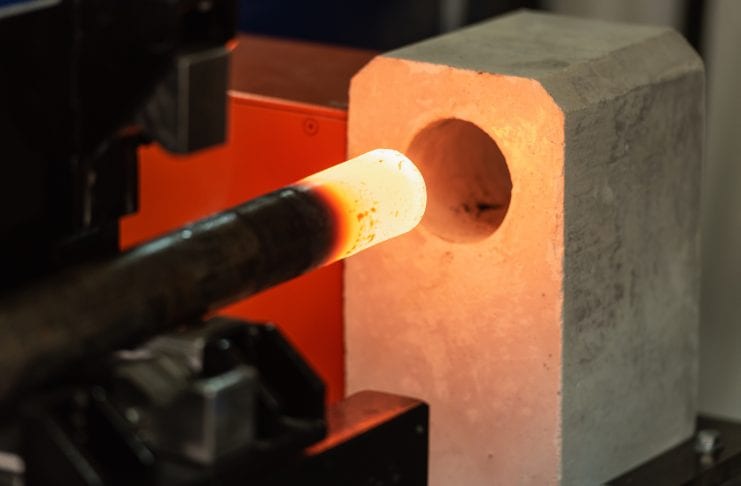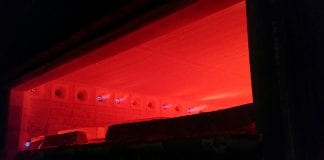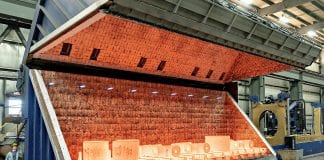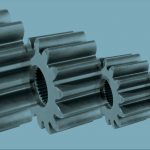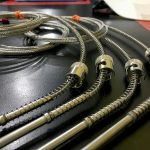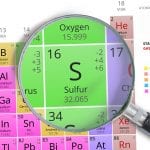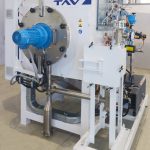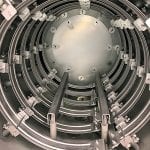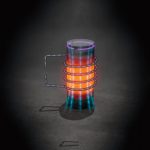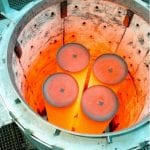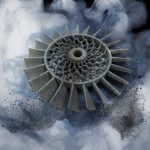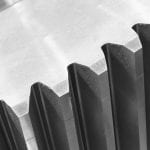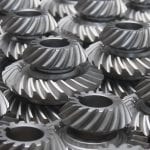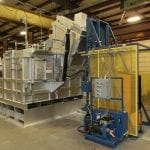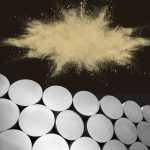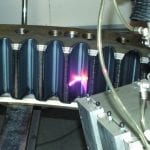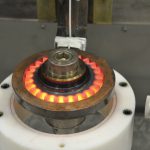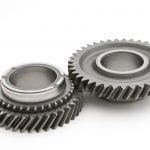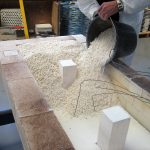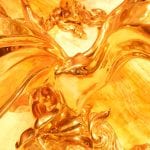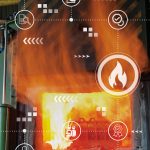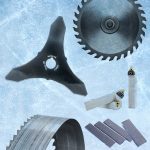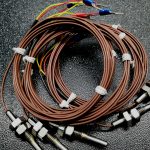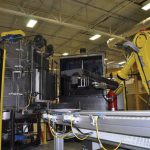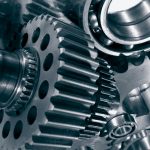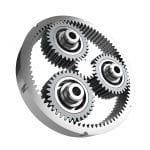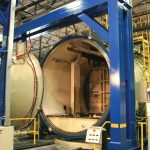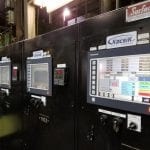Reducing measurement error when making thermocouple transmitter connections
The thermocouple (TC) is a thermo-electric device used to measure temperature and nearly two-thirds of U.S. temperature measurement makes use of thermocouples. Most industrial...
Experimental validation of high-spatial resolution of two-color optical fiber pyrometer
Taking non-contact temperature measurements in narrow areas or confined spaces of non-uniform surfaces requires high spatial resolution and independence of emissivity uncertainties that conventional...
Contour Hardening Bevel, Hypoid, and Pinion Gears
Traditional gear heat treatment involves gas carburizing in batch or continuous furnaces for an extended time, and then oil quenching. The gears are typically...
Mechanical properties and thermal conductivity of lightweight and high-strength carbon-graphite thermal insulation materials
Thermal insulation composites are widely used in civil and military applications; however, it is difficult to achieve the synergy of multiple technical objectives such...
Reducing Gear Size for Compact Transmission Design by Selecting Steel Grade and Heat Treatment...
Gears are the most important components for transmissions. In many situations, the size of a transmission design needs to be reduced without decreasing power...
Understanding pyrometry technology is key to proper use
I teach pyrometry courses throughout the year and, when I do, I include a thermocouple tutorial video from YouTube. In this video the function...
Efficient Gas Heating of Industrial Furnaces
There are various types of high-efficiency gas burners and radiant tubes currently on the market, and economic tools can be used to assess investments...
Detrimental Effects of Sulfur on Transverse Impact Properties in Steel Forgings
Anyone who has supplied or processed forgings for the power generation, oil and gas, or shipbuilding industries, among others, is familiar with Charpy impact...
How to properly debind parts produced by metal AM
Additive manufacturing is a manufacturing technology that is gaining more and more ground among metallurgists. The process involves all the techniques used to create...
AC7102 Checklist Review, Part 2
Editor’s note » This is the second of a five-part series of articles that will deconstruct the requirements of AC7102. Each article will appear every...
Vacuum heat treatment for additive manufacturing
Additive manufacturing means any technology capable of obtaining a final component starting from a 3D CAD file and adding material layer by layer. At...
Inductive Spin Hardening of Gears: A Survey of Key Features and Benefits
A large part of the misunderstanding of induction hardening seems to stem from an incomplete grasp of the basic induction heating process. This is...
Principles of pyrometry
Regarding comprehension, on a scale of 1 to 10, AMS2750E is about a 12. Practically speaking, when an engineer, quality person, or operator picks...
Heat treatment of PM parts by hot isostatic pressing
Several advantages can be seen by using pre-stressed wire-wound hot isostatic presses for consolidating of metal powder.
Gas solutions for sustainable metal AM
Sustainability is a key value driver and focus for industrial manufacturing, and additive manufacturing fulfills that need in more ways than one.
Additive manufacturing,...
Improved Materials and Enhanced Fatigue Resistance for Gear Components
For decades, the gear industry has addressed the challenge to produce high-performance components in a cost-effective manner. To meet design intent, vehicle transmission components...
Single-piece flow case hardening can be worked into in-line manufacturing
Case hardening by carburizing is the most common heat treatment in mass production, which relies on atmosphere or vacuum carburizing followed by oil or...
Company Profile: Lindberg/MPH
Lindberg/MPH has been around for over 100 years. During that century, it has changed hands and names, but since it became part of Thermal...
10 steps for accelerating thermal processing decarbonization
Companies throughout the thermal-processing sector are under increased pressure to meet CO2 emission reduction goals, particularly net-zero emissions, by 2050 or sooner. At the...
Investigations on Tooth Root Bending Strength of Case Hardened Gears in the Range of...
Gears are one of the critical components that determine the capability and reliability of drive systems. Thus the tooth root load-carrying capacity is one...
Using FAST-forge to produce near net shape forgings from surplus AM powder
Titanium alloys are used extensively in the aerospace sector due to the good combination of high strength-to-weight ratio and corrosive resistance. Many aerospace components...
The tribology of dental ceramics
Ceramics are widely used in dentistry due to their ability to mimic the optical characteristics of enamel and dentine, as well as their biocompatibility...
Case Study: Laser Hardening
To increase the hardness of a steel material, there are basically three required steps in the hardening process. Step one is to heat the...
Carburizing and Nitriding Treatment Modeling
(Photo courtesy of Advanced Heat Treat Corp.)
Carburizing and nitriding treatments have the same goal: increase hardness on the surface while keeping the core ductility....
Some Basic Mathematical Elements On Steel Heat Treating: Modeling, Freeware Packages And Numerical Simulation
Every year since 2007, in June, a Modeling Week is held within the master program of the faculty of Mathematics of Universidad Complutense of...
Coupling CFD and Oil Quench Hardening Analysis of a Gear Component
Today, powertrain development is driven in the direction of weight reduction by replacing heavier components with low-cost or higher strength alloys for industries such...
Carbon-neutral insulation for high-temperature applications
In January 2022, Mantec Technical Ceramics, based in Stoke-on-Trent, U.K., launched carbon neutral versions of its super-insulative Ultralite material, and this has been met...
Selection of Oil Quenchants for Heat-Treating Processes
Modern quenching oils offer a wide range of capability and performance. The selection of the proper quench oil is critical for proper heat-treating operations....
AC7102 Checklist Review, Part 1
Editor’s note » This is the first of a six-part series of articles that will deconstruct the requirements of AC7102. Each article will appear every...
Aerospace Forging Market: An Avenue of Opportunities
Forging is a manufacturing process that has come a long way in the last century. In simple terms, forging is a process of shaping...
Combustion optimization in gas burners of reverberatory Furnaces during nickel-alloy melting
In recent years, due to climate change, environmental sustainability programs have been created that require the search for alternatives to reduce air emissions and...
Cryogenic processing for longer tool life
In almost every industrial trade magazine, there will appear an occasional article about “cryogenics.” Thermal Processing has devoted an annual issue to cryogenic processing...
Using the correct thermocouple
The principles behind how and why a thermocouple functions were beginning to be understood in the early 1800s with most significant developments taking place...
The advantages of pulse plasma nitriding
In the gear manufacturing industry, when case-hardening, tempering, or nitriding the surface of steel, whether for gears or gearboxes, the options have traditionally included...
Improving Production Safely with Integrated Heat Treat and Quenching Cell
These aspects are not just requested, but increasingly required by industrial clients looking to install new thermal systems or expand or enhance existing processes...
Reliable Vacuum Supply for Plasma Nitriding
Plasma nitriding is becoming more and more important for heat treatment.
Carburized steel mechanical properties: Bending ultimate and impact strength
Editor’s note » This is part three of a three-part series on carburized steel mechanical properties.
In Part 2, it was determined that a test...
Analysis of Heat Treat Growth on Carburized Ring Gear and Multivariate Regression Model Development
In gear manufacturing and machine assembly, dimensional stability of each component and conformance to print requirements are of critical importance. During processing, dimensional changes...
Vacuum Carburizing Large Gears
Throughout the machining process, great care is taken to achieve and maintain critical dimensions. The gears are then handed over for heat treatment. Exposing...
Case Study: Conrad Kacsik and Modern Industries
Modern Industries, one of the largest heat-treating facilities in Pennsylvania, has seen its share of equipment come and go since its beginning 71 years...










